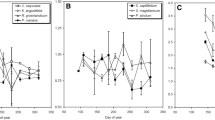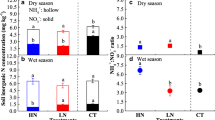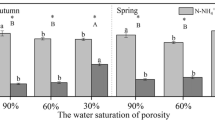Abstract
This study investigated the nitrogen (N) acquisition from soil and insect capture during the growth of three species of pitcher plants, Nepenthes mirabilis, Cephalotus follicularis and Darlingtonia californica. 15N/14N natural abundance ratios (δ15N) of plants and pitchers of different age, non-carnivorous reference plants, and insect prey were used to estimate proportional contributions of insects to the N content of leaves and whole plants. Young Nepenthes leaves (phyllodes) carrying closed pitchers comprised major sinks for N and developed mainly from insect N captured elsewhere on the plant. Their δ15N values of up to 7.2‰ were higher than the average δ15N value of captured insects (mean δ15N value = 5.3‰). In leaves carrying old pitchers that are acting as a N source, the δ15N decreased to 3.0‰ indicating either an increasing contribution of soil N to those plant parts which in fact captured the insects or N gain from N2 fixation by microorganisms which may exist in old pitchers. The δ15N value of N in water collected from old pitchers was 1.2‰ and contained free amino acids. The fraction of insect N in young and old pitchers and their associated leaves decreased from 1.0 to 0.3 mg g−1. This fraction decreased further with the size of the investigated tiller. Nepenthes contained on average 61.5 ± 7.6% (mean ± SD, range 50–71%) insect N based on the N content of a whole tiller. In the absence of suitable non-carnivorous reference plants for Cephalotus, δ15N values were assessed across a developmental sequence from young plants lacking pitchers to large adults with up to 38 pitchers. The data indicated dependence on soil N until 4 pitchers had opened. Beyond that stage, plant size increased with the number of catching pitchers but the fraction of soil N remained high. Large Cephalotus plants were estimated to derive 26 ± 5.9% (mean ± SD of the three largest plants; range: 19–30%) of the N from insects. In Cephalotus we observed an increased δ15N value in sink versus source pitchers of about 1.2‰ on average. Source and sink pitchers of Darlingtonia had a similar δ15N value, but plant N in this species showed δ15N signals closer to that of insect N than in either Cephalotus or Nepenthes. Insect N contributed 76.4 ± 8.4% (range 57–90%) to total pitcher N content. The data suggest complex patterns of partitioning of insect and soil-derived N between source and sink regions in pitcher plants and possibly higher dependence on insect N than recorded elsewhere for Drosera species.
Similar content being viewed by others
Author information
Authors and Affiliations
Additional information
Received: 14 April 1997 / Accepted: 18 August 1997
Rights and permissions
About this article
Cite this article
Schulze, W., Schulze, E., Pate, J. et al. The nitrogen supply from soils and insects during growth of the pitcher plants Nepenthes mirabilis, Cephalotus follicularis and Darlingtonia californica . Oecologia 112, 464–471 (1997). https://doi.org/10.1007/s004420050333
Issue Date:
DOI: https://doi.org/10.1007/s004420050333




